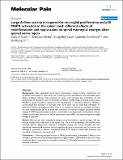| dc.contributor.author | Suter, Marc | |
| dc.contributor.author | Berta, Temugin | |
| dc.contributor.author | Gao, Yong-Jing | |
| dc.contributor.author | Decosterd, Isabelle | |
| dc.contributor.author | Ji, Ru-Rong | |
| dc.date.accessioned | 2011-02-20T20:34:50Z | |
| dc.date.issued | 2009 | |
| dc.identifier.citation | Suter, Marc R., Temugin Berta, Yong-Jing Gao, Isabelle Decosterd, and Ru-Rong Ji. 2009. Large A-fiber activity is required for microglial proliferation and p38 MAPK activation in the spinal cord: Different effects of resiniferatoxin and bupivacaine on spinal microglial changes after spared nerve injury. Molecular Pain 5: 53. | en_US |
| dc.identifier.issn | 1744-8069 | en_US |
| dc.identifier.uri | http://nrs.harvard.edu/urn-3:HUL.InstRepos:4728492 | |
| dc.description.abstract | Background: After peripheral nerve injury, spontaneous ectopic activity arising from the peripheral axons plays an important role in inducing central sensitization and neuropathic pain. Recent evidence indicates that activation of spinal cord microglia also contributes to the development of neuropathic pain. In particular, activation of p38 mitogen-activated protein kinase (MAPK) in spinal microglia is required for the development of mechanical allodynia. However, activity-dependent activation of microglia after nerve injury has not been fully addressed. To determine whether spontaneous activity from C- or A-fibers is required for microglial activation, we used resiniferatoxin (RTX) to block the conduction of transient receptor potential vanilloid subtype 1 (TRPV1) positive fibers (mostly C- and Aδ-fibers) and bupivacaine microspheres to block all fibers of the sciatic nerve in rats before spared nerve injury (SNI), and observed spinal microglial changes 2 days later. Results: SNI induced robust mechanical allodynia and p38 activation in spinal microglia. SNI also induced marked cell proliferation in the spinal cord, and all the proliferating cells (BrdU+) were microglia (Iba1+). Bupivacaine induced a complete sensory and motor blockade and also significantly inhibited p38 activation and microglial proliferation in the spinal cord. In contrast, and although it produced an efficient nociceptive block, RTX failed to inhibit p38 activation and microglial proliferation in the spinal cord. Conclusion: (1) Blocking peripheral input in TRPV1-positive fibers (presumably C-fibers) is not enough to prevent nerve injury-induced spinal microglial activation. (2) Peripheral input from large myelinated fibers is important for microglial activation. (3) Microglial activation is associated with mechanical allodynia. | en_US |
| dc.language.iso | en_US | en_US |
| dc.publisher | BioMed Central | en_US |
| dc.relation.isversionof | doi:10.1186/1744-8069-5-53 | en_US |
| dc.relation.hasversion | http://www.ncbi.nlm.nih.gov/pmc/articles/PMC2759920/pdf/ | en_US |
| dash.license | LAA | |
| dc.title | Large A-Fiber Activity is Required for Microglial Proliferation and p38 MAPK Activation in the Spinal Cord: Different Effects of Resiniferatoxin and Bupivacaine on Spinal Microglial Changes after Spared Nerve Injury | en_US |
| dc.type | Journal Article | en_US |
| dc.description.version | Version of Record | en_US |
| dc.relation.journal | Molecular Pain | en_US |
| dash.depositing.author | Suter, Marc | |
| dc.date.available | 2011-02-20T20:34:50Z | |
| dash.affiliation.other | HMS^Anaesthesia-Brigham and Women's Hospital | en_US |
| dash.affiliation.other | HMS^Anaesthesia-Brigham and Women's Hospital | en_US |
| dash.affiliation.other | HMS^Anaesthesia-Brigham and Women's Hospital | en_US |
| dc.identifier.doi | 10.1186/1744-8069-5-53 | * |
| dash.contributor.affiliated | Gao, Yong-Jing | |
| dash.contributor.affiliated | Ji, Ru-Rong | |
| dash.contributor.affiliated | Suter, Marc | |
| dash.contributor.affiliated | Berta, Temugin | |


